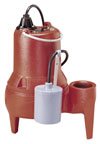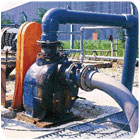Some things to consider to help prevent a disaster from occurring at the specification level.
The ejector pit: It is the last thing any building owner wants to think about. To the building owner, it’s the dirty, smelly, disgusting corner of his basement. Unfortunately, sooner or later the owner is faced with the reality of a pump or control system that has failed them, and water is rising and threatening to cause damage. Property, profits, and face can be lost due to this unnatural disaster.
This article explores the inner workings of ejector systems - specifically, the ejector basin, the different types of ejector pumps, and system controls.
The Ejector Basin
We begin with the ejector basin itself, which also is known as a wet well, sump, or pit. The basin is available in different types of materials: fiberglass, polypropylene, steel, cast iron and concrete. Selection of basin material is usually determined by size, local code, and, of course, cost. Basin size is the most important part in this crucial first step of ejector system design. The basin should be sized along side of the selection of pumps, controls, and accessories. The bigger the basin, the better.

Vertical pumps have been around the longest of the ejectors, around 100 years. This is a 1/3-hp unit. Photo courtesy of Liberty Pumps Inc.
By sizing the basin properly you will allow for enough room for all equipment in the basin and for proper access from above through the basin cover. The size of the basin will vary, of course, on the amount of flow coming into the basin and the depth of the lowest inlet.
Here is a rule of thumb for proper usable basin space: Proper level control requires a minimum of four feet from the lowest inlet to the bottom of the basin, and you need at least a foot on the outside of each pump and a foot between them (if not more) depending on the type of media you will be pumping. Most codes state that the minimum sump level is three feet below the lowest inlet; in most cases, this is simply not enough.
With that said, the demands of modern day building design may not allow for this. This is where your knowledge of the application will cause you to fight for that space or make the decision to allow for a smaller pit. When should one fight for that space? When is it ok to shrink the size of the pit? Any application where solids will be introduced to the basin should raise a red flag.
The absolute worst application in a commercial building is a basin that receives waste from a grease trap. Grease is a very challenging media for any ejector pump. The size of the basin can be a huge disadvantage; a larger basin than normal is only a slight advantage. Grease rises to the top of the pit and hardens. It forms a crust on the top of the water that is unbreakable by inflow. This can destroy control systems, power cords, and eventually the pump itself.
Having enough room in the pit will make it less likely to hang up controls and allows room for the necessary maintenance from above. Even in applications where normal toilet waste is the only thing being drained into the pit, the debris that can build up in the pit can be stifling to a level control system. If the only water entering the pit is clear and is merely storm drainage, you may in this case not have to worry about room for solids, but rather a massive inflow caused by a 100-year rain.
Whatever the case, the manufacturers of the pumping systems are the best people to turn to for a recommendation on the basin size. They will know the space requirements of their equipment and can assist you in determining load.
Finally, when it comes to the basin cover, think access. The owner will at some point want to peek his/her head in the basin to see what’s going on. Give them more than a hand hole. When it comes to systems using submersible pumps, a large access opening is inherent for each pump; 18 inches round per pump in most cases.

This is a 1/2-hp submersible sewage pump, the Model LE51A. It features all-cast-iron construction and 2-inch solids-handling capabilities. Photo courtesy of Liberty Pumps, Inc.
The Pumps
Although there are many types, variations, and different features of ejector pumps, it really comes down to three types: submersible, vertical, and self-priming.
Submersible pumps are the most common. If you have a sump pump in your house, most likely it is a submersible type. These pumps started to become common in the 1950s. Submerging electric motors into water was taboo before then, but since the advent of submersible motors, submersible pumps have become quite common and safe. There are single-seal submersible pumps and double-mechanical-seal pumps. Obviously, two seals are better than one.
The cost difference between these two can be significant. How I select which type (one seal or two) is frequency of use. If the pump will run only a few times per day or if it will not run every day, a single-sealed pump will do just fine. However, if the pump will run many times per day or frequently, a more-reliable double-sealed pump is a must. These pumps sit on the bottom of the pit, but are available with a rail-type removal system. The rail system is imperative for high use and troubled applications.
Submersibles also are available in cutter, chopper, grinder, and non-clog hydraulic designs. The manufacturers are pretty clear about what types of debris their pumps can handle. In most applications, a standard non-clog impeller will be fine. If you have long stringy solids, many paper towels, or anything other than normal toilet waste, look to the manufacturer for a recommendation.
Vertical pumps have been around the longest of the ejectors, about 100 years. These pumps tend to be very large, yet durable. These pumps are not as prevalent as they once were due to their size and cost. However, they still perform quite well. The pumping portion of the vertical pump is submerged in the pit, and the motor rests on a plate that also supports the rest of the pump shaft, discharge pipe, and volume.
Unlike the permanently lubricated submersible pump, these pumps can have several sleeve bearings along its shaft. These sleeve bearings require grease lubrication quarterly or more often based on use. If properly maintained, these pumps can last a very long time. Please remember: These pumps are not rated for continuous duty. Due to the use of sleeve bearings, intermittent operation only is recommended.
Self-priming pumps are normally used in applications where there is not much headroom if the pump ever had to be removed. These pumps sit on top of the pit. They are fully primed when full of water. Once primed, they will remain so as long as air is not introduced to the casing. Generally, these pumps can remain primed for years without having to be re-primed. The best feature these pumps have is that they are accessible because the pump and motor are on top of the pit. Their performance is limited by depth, but generally, they work well in shallow pits. In deep pits they can lose performance. Consult with the manufacturer for recommended depths.

Self-priming pumps are normally used in applications where there is not much headroom if the pump ever had to be removed. Photo courtesy of The Gorman-Rupp Co.
The Controls
Other than pump selection, the controls are the most important part of the ejector system. This is where most plumbing engineers rely on the manufacturer the most. However, having knowledge of these controls can go a long way. The control panel is the brain and electrical center of the ejector system. There are a few things you should know and watch for when designing these systems.
[1] The NEMA environmental rating system of the control panel is used to protect the control panel from its surrounding elements.
Type 1. For indoor use. Provides a degree of protection against falling dirt.
Type 2. For indoor use. Provides a degree of protection against falling dirt and dripping and light splashing water.
Type 3R. For indoor or outdoor use. Provides a degree of protection against falling dirt; against rain, sleet, snow; and will be undamaged by the external formation of ice on the enclosure.
Type 4. For indoor or outdoor use. Provides a degree of protection against falling dirt and windblown dust; against rain, sleet, snow, splashing water, and hose-directed water; and will be undamaged by the external formation of ice on the enclosure.
Type 4X. Same as NEMA 4, but constructed with a corrosion-resistant material such as stainless steel or fiberglass-reinforced plastic.
Type 6P. For indoor or outdoor use. Provides a degree of protection against falling dirt and windblown dust; against hose-directed water and the entry of water during prolonged submersion at a limited depth; provides an additional level of protection against corrosion and will be undamaged by the external formation of ice on the enclosure. (This rating usually is only applied to junction boxes located in the pit).
Type 7. For indoor use. Enclosures constructed for indoor use in hazardous locations classified as Class I, Division 1, Groups A, B, C, or D as defined in NFPA 70.
Type 12. For indoor use. Enclosures constructed (without knockouts). Provides a degree of protection against falling dirt and circulating dust, lint, fibers, and flyings and against dripping and light splashing water.

Drawing of a four-float system for duplex pumping. When the level rises, the float switches activate.
[2] The control panel should be within site of the ejector pit, preferably directly next to it.
This is for testing, troubleshooting, and safety. The control panel should have a main disconnect through the door. This is so you cannot open the door without disconnecting the power. This disconnect should be protected by fuses or circuit breaker.
Other protection features should include the following: branch circuit protection for each pump in the form of fuses or circuit breaker; starter with low voltage, high voltage, and overload protection; step-down control transformer with primary and secondary fuses; through-the-door hand-off auto switch for each pump; through-the-door run light for each pump; and an audio-visual high-water alarm (i.e., light and horn).
The alarm warning is the last defense again flooding. This obviously makes it very important. The best alarm system in a duplex (two pump) system is having a lag pump run alarm and a high-water alarm. The high-water alarm should be made by a separate float or isolated contact. Both of these alarms should be connected to building automation, so your specification will have to call for two dry contacts (normally open, one for each alarm). Even if the alarm is reset at the control panel, the operating engineer will have to acknowledge the alarm in the automation system.
[3] Level controls turn the pumps on and off.
There are three major types of ejector level controls: tethered floats, pedestal mechanical floats, and level transducers.
Tethered Floats are plastic capsules that contain a mechanism that closes contact when its level rises. These floats are attached to a two-wire cable that is terminated to the control panel. In a simplex (one pump) system there are three floats (off, on, and high-water alarm). In a duplex system, there are four floats (off, lead pump on, lag pump on, and high-water alarm). When tethered floats are used, the control panel must have an electronic alternator for the lead pump to be alternated.
Duplex operation works as follows: As the water level rises, the off float is activated first. As the level rises, the lead pump on float activates next. This will cause pump number one to run until the water level lowers to the point of deactivating the off float. Upon deactivation of the off float, the electric alternator will alternate the lead pump. This will occur every time the off float deactivates.
If the water level rises above the lead pump on float, this means that either pump one cannot keep up with the inflow or it has a problem. This will cause the lag pump on float to activate. This is a good level to alarm since each pump should be sized to handle 100% of the total load. If the water level continues to rise past this point, then, of course, the high-water alarm float will activate.
Pedestal Floats have a stainless steel rod with a stainless steel ball at the bottom. The ball rises with the water, which causes a lever above the pit to trigger the off, on, lag, and high-water alarm levels. These switches can have built-in mechanical alternators that take the place of the electric alternators. The mechanical alternators are far more reliable, durable, and easier to troubleshoot.
Because the lever actuator itself is above the basin, you can test the levels easily. However, they are limited usually to about two feet of pump down. If you have a deep pit with a large pump down requirement, you must use tethered floats or a level transducer. If you still want to use a pedestal switch, you can use a sliding float, which will delay turning on a pump.
Level Transducers are the newest technology to be used in ejector systems. A level transducer is a device that sits at the bottom of the pit and can accurately measure the level of the pit at all times. Off, on, lag, and high-water levels are programmable through a microprocessor. Level transducers are very reliable due to their early detection of rising levels.
In addition, the microprocessor can detect if the transducer has failed. With the other level controls, we do not know about the device failing until it is too late. Although this is great technology, be prepared for a much higher cost than the other two systems. However, long-term payback is priceless when disaster is thwarted.

Drawing of a pedestal mechanical alternator. This one assembly operates off, on, lag and high-water alarm. Troubleshooting and testing can be performed from above.
Conclusion
The best way to avoid failure when it comes to ejectors is to make sure the entire system is right for the application. Work closely with the manufacturers, and specify quality and features with inherent benefits. Size the basins to allow for room to work. Be sure to connect the alarms to building automation and be sure to alarm early. Lastly, ensure maximum protection and a user-friendly control system to protect your clients from a very unnatural disaster.
